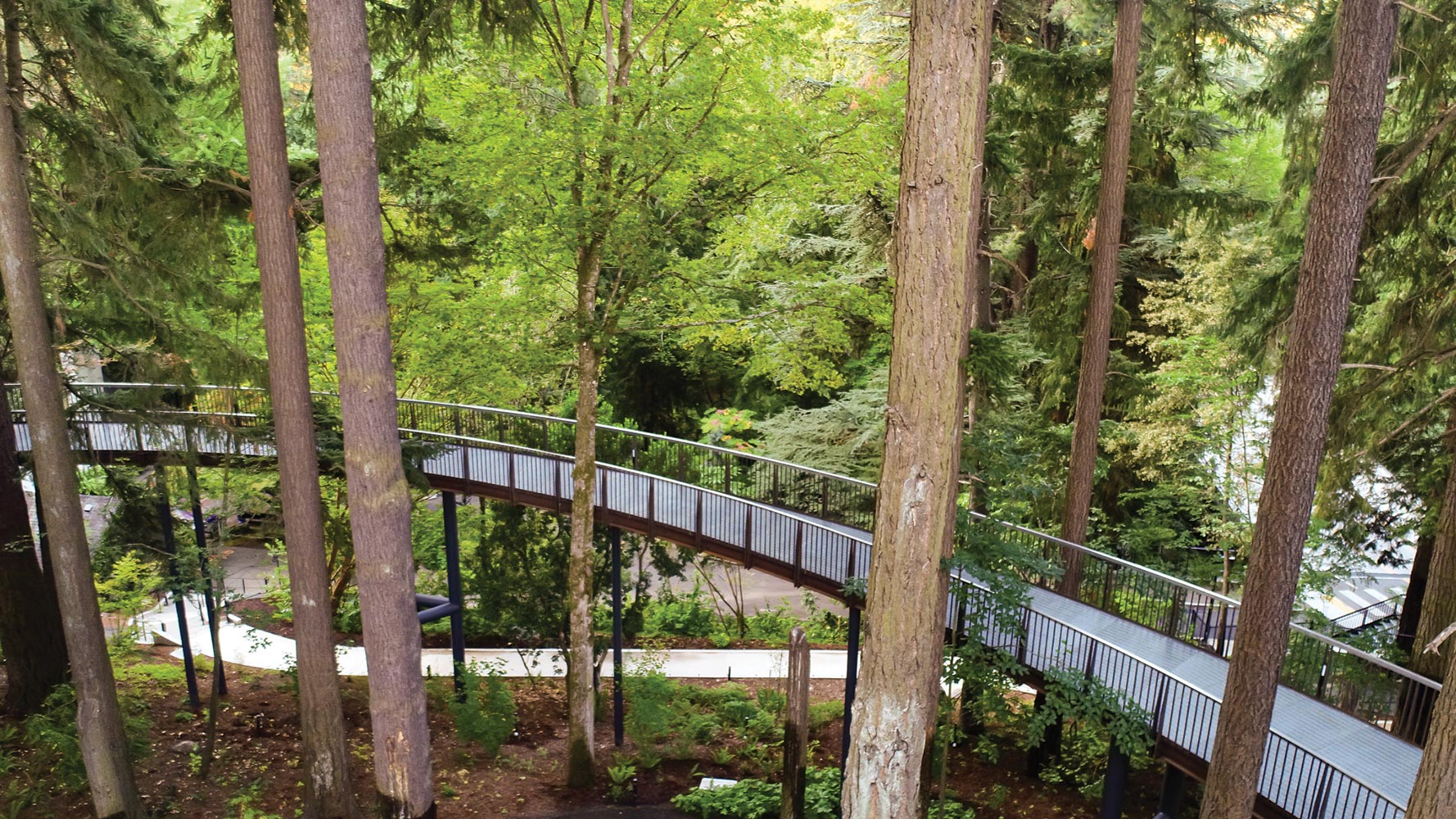Land Morphology Creates an Architectural Dreamscape for Leach Botanical Garden
Portland, Oregon

Architects & Firms
Of Portland’s many notable public gardens, the one most cherished by Oregon plant geeks is Leach Botanical Garden—for its horticulture, but also its story. The largely self-trained botanist Lilla Leach became a Northwest hero for her discovery of several previously unknown species in the state’s Siskiyou Mountains. One earned her name, Kalmiopsis leachiana, a find that led to the creation of the 180,000-acre Kalmiopsis Reserve, one of the most botanically diverse areas in the U.S. From the 1930s to early ’70s, she and husband John Leach, a pharmacist, transformed a five-acre former lumber mill, 12 miles from central Portland, into a home for themselves and a casually sumptuous array of some 3,000 native and exotic species.
Gifted to the city in the ’70s, the Leaches’ storied house and garden became a magnet for plant-loving volunteers. But with the acquisition of 10 additional acres, it turned into a growing drain and question mark in the city budget. So in 2014, Portland Parks & Recreation (PPR) released an RFQ for a modest master plan update and a $1.3 million new entry garden and parking lot. The major agenda: give Leach a new, more prominent front door and a push toward stronger admission- and event-driven financial performance. Top local and regional landscape firms applied, but Richard Hartlage and Sandy Fischer of the newly formed Seattle firm Landscape Morphology “threw a bold schematic design on the table,” according to PPR project manager Ross Swanson.
“We basically argued, ‘Why are you building more parking?’ ” recalls Hartlage, a veteran plantsman and executive director of several botanical gardens before founding Land Morphology. “What you need is something extraordinary to get people to come.”
Once hired, Hartlage and Fischer’s team (with Olson Kundig as consultant) continued coloring outside the scope’s pinched lines, turning the original job into a $32 million vision and a recently completed $12.6 million first phase.
The master plan is a horticultural and architectural dreamscape featuring everything from a native oak savanna to individual gardens that highlight aquatics, moss, chroma, physics, and children’s learning. Guided by Hartlage’s deep experience with the financial realities of public gardens, each area features carefully right-sized spaces for classes, weddings, and other income generators—all phased and, for the right price, named.
Underlying botany and spreadsheets are two architecturally muscular transects. East to west is the “cultural,” bracketing the Leaches’ modest Arts & Crafts house (now a gift shop and meeting center) with various more formal display gardens. South to north is the “environmental,” versions of natural habitat rising from a major creek to a large new pollinator meadow. It terminates with an Olson Kundig–designed open-air event space (completed) and, should the remainder of the master plan be executed, with high-performance buildings for offices and more events, all ethereally wrapped in sustainably harvested lath.

At its highest point, the curving tree walk is 39 feet above the ground. Photo © Land Morphology, click to enlarge.
Early in the team’s work, Hartlage’s goal for “something spectacular” emerged: an aerial tree walk. The first concept cantilevered from hillside into treetop. Leach’s steering committee quickly dubbed it the “diving board” as too architecturally alien and the out-and-back experience too boring. The team then developed a circular stroll between land and treetops. Finally, after a Hartlage/Fischer drawing session: an oval. “It’s more elegant,” Hartlage says. “At the widest points, you can host a gathering or a plein air painting class, but as it narrows at the highest point, you get a sense of excitement and a little peril.” The tree walk and a large connecting pollinator meadow—and a small parking lot—became the hook that quickly captured the imaginations of politicians and fundraisers, who, together, found the government grants and private donations for the nearly tenfold increase in budget.

1

2
The tree walk has an open grate underfoot (1). An open-air event space is the first of several planned wood structures (2). Photos © Land Morphology
Visitation has doubled since the tree walk opened in March 2021. (The pandemic delayed any reliable metrics of rentals and classes.) The meadow now blossoms in an immersive kaleidoscope of 200-plus species. The tree walk’s ellipse offers a sweeping horizontal contrapuntal to the treetops’ soaring staccato. Seen from below, the tree walk’s thick supporting columns read like kinfolk to neighboring Douglas firs. Underfoot, the walkway’s open grate pairs function (self-cleaning) with the excitement of levitating 35 feet off the ground—a good analogy for the leap beyond the parking lot that Leach Botanical made with Land Morphology.
Click plan to enlarge




